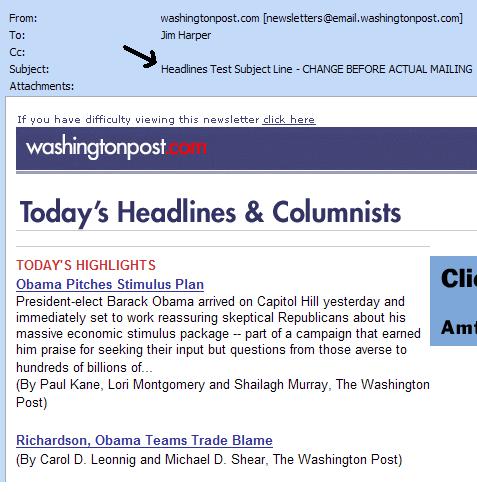. . . a Senior Program Coordinator.
Keeping politicians' hands off the Net & everything else related to technology
You wouldn’t think that a book called In Search of Jefferson’s Moose could be about the Internet, but it is.
In his book, In Search of Jefferson’s Moose: Notes on the State of Cyberspace, Temple University Law Professor David Post draws remarkable and entertaining parallels between the Internet and the natural and intellectual landscape that Thomas Jefferson explored, documented, and shaped.
Post will be at the Cato Institute for a lunch-hour book forum on Wednesday, February 4th. Clive Crook and Jeffrey Rosen will comment.
Register here to see just how nicely Thomas Jefferson, cyberspace, and a rather large moose fit between the covers of Post’s new book.
My post yesterday wondering aloud whether the Obama administration was walking away from its transparency commitments was slightly premature. Memoranda were being issued/reported on as I wrote, and this morning’s Washington Post describes some of the technical glitches that befuddled White House staff on day one. The texts of the executive orders President Obama signed yesterday are now online, but his memoranda on transparency aren’t yet. Helpfully, they’ve been posted by the Sunlight Foundation.
But I think my post was sound in the main, because I was looking for actual pro-transparency deeds from the new administration, and they haven’t materialized. I appreciate the sentiments voiced in these documents, but don’t find myself wholly impressed with the actual transparency measures the White House has taken.
What I’m hearing is the transparency dog that didn’t bark: The Obama team set a great precedent in the transition with the Seat at the Table program, but there’s no sign that such a thing will be implemented in the White House. Why not?
We can expect an “Open Government Directive” within 120 days and new guidelines for the Freedom of Information Act, but I would have appreciated seeing President Obama’s commitment to openness illustrated the best way possible: through the direct and immediate commitment of his own White House operation.
The White House will not be run as openly as the transition was. The agencies, already predisposed against transparency, will see this as a sign of weak commitment and will whittle away even more fiercely at the good sentiments President Obama’s expressed in his transparency memoranda.
(“Thanks for inviting me!” said the skunk at the garden party.)
 You’d have to get your picture taken at the DMV.
You’d have to get your picture taken at the DMV.
“It’s stressful and degrading and my nose and chin look shiny,” says a one-time TLF blogger (not pictured here).
The woman pictured here was arrested for driving without a license. Perhaps because she didn’t want to get her picture taken at the DMV.
Say No to the national ID law – and to those trips to the DMV!
Hey, you’d make mistakes too if you were up at 5:00 a.m. sending emails.

Mark Cuban probably didn’t know how much he’d rev up the hypocrisy meter when he suggested that the government should report its own spending and other financial information in XBRL. The SEC recently announced that it would require public companies to do their financial reporting in the format.
Having the government do it to is a GREAT idea.
And it will take years for that to happen.
Why? Because releasing information in a usable form is like releasing power. Agencies and bureaucrats aren’t in the business of giving away power.
I won’t lay predictions because the idea is so good that it may catch a head of steam, unify the transparency community, and get high-level attention in the administration. But barring that, it will be a cold day (today happens to be a cold day) when the government adopts XBRL. Until then, the hypocrisy meter is rising.
The intrepid Chris Soghoian has turned up an important wrinkle in Google’s services. Google pulled his AdWords ad pointing out AT&T’s campaign contributions to an Indiana politician after AT&T lodged a trademark complaint about it.
Trademark law is for preventing confusion about the source of goods and services. There is no possibility that Chris’ ad would confuse consumers in this way. He’s not providing telecommunications services, and his ad didn’t suggest it. Chris’ use of “AT&T” did not violate AT&T’s trademarks.
The subject matter of Chris’ ad is an important part of our national discourse, and something people should be able to run ads about on a platform like Google. It would be, well, evil, to kick small public policy advocates to the curb in favor of big corporations.
A company like Google is in a tough spot, of course, trying to adjudicate trademark claims at scale. But it is not acceptable to treat trademark complaints as proven just for having been submitted.
Google should take some steps to make its process more fair, such as by allowing advertisers to respond to a trademark complaint before Google acts on it. Much of the process could be automated, and it could explain to both sides what trademark rights include – and what they don’t. If after a few automated steps, the two remained at loggerheads, Google employees could take a look to see whether the claim or the response were meritorious. (A trained monkey could have determined that Chris’ ad is not a trademark violation.)
In close cases, Google should leave it to the parties to resolve, while it works in the courts to generate a substantive body of law that service providers in the position of Google are not properly liable for the trademark infringements of users. (My brief pitch for common law findings of “no liability” in such situations – as opposed to statutory protections like CDA section 230 – starts at minute 22 of this video.)
Would these ideas increase Google’s cost and potential liability? Yes, some. But Google should embrace those costs as it educates its users, employees, courts, and – most important – trademark holders about what trademark does and does not do.
Kudos to Chris for his tenacity. Google, fix this.